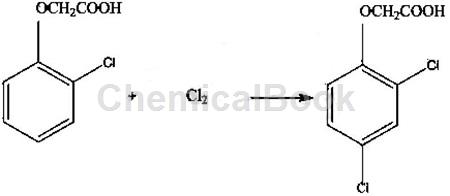Background and overview[1]
O-chlorophenoxyacetic acid is an acidic organic compound that can be used as an intermediate for pharmaceutical and chemical synthesis. If o-chlorophenoxyacetic acid is inhaled, please move the patient to fresh air; if the skin comes into contact, take off contaminated clothing, rinse the skin thoroughly with soap and water, and seek medical treatment if you feel uncomfortable; if the eyes come into contact, seek medical attention. Separate eyelids, rinse with running water or saline, and seek medical attention immediately; if ingested, rinse mouth immediately, do not induce vomiting, and seek medical attention immediately.
Apply[2-3]
O-chlorophenoxyacetic acid can be used as an intermediate for pharmaceutical and chemical synthesis. Examples of its application are as follows:
1. Preparation of 2,4-dichlorophenoxyacetic acid. Using o-chlorophenol as raw material, it first reacts with chloroacetic acid to generate o-chlorophenoxyacetic acid, and then o-chlorophenoxyacetic acid and chlorine are reacted in a mixed solvent to obtain 2,4-dichlorophenoxyacetic acid. The mixed solvent is DMF , a mixture of water and dichloroethane. The reaction equation is:

The specific steps are as follows: Take 100g of o-chlorophenoxyacetic acid dry material, add it to a 1000ml four-necked flask, and then add 100g of DMF (N, N-dimethylformamide) and 15g of water into the flask. , 150g of dichloroethane, then mix to completely dissolve the solid, then raise the temperature to 30°C and start to pass in chlorine gas. After passing 38.5g of chlorine, take a sample and check. The unconverted rate is 0.4%. Then turn on the vacuum pump and control the vacuum degree in the flask to 0.09Mpa. Then raise the temperature to remove the solvent. The end temperature is 95℃ and 260g of solvent is removed. Finally, add 200g of water into the flask and start cooling and crystallization. Lower to room temperature, filter and dry to obtain 116.3g of 2,4-D dry material, 2,4-D content 97.1%, 2,6-dichlorophenoxyacetic acid content 0.5%, 2,4,6-trichlorobenzene Oxyacetic acid content is 1.1%. The yield in this step is 96.8%. 212.6g of filtrate was obtained. Add 20g of dichloroethane to the filtrate, perform extraction and then separate layers to obtain lower aqueous phase A: 211.7g. The oil phase recovered 19.8g of dichloroethane through distillation.
Preparation[1-2]
Cetyltrimethylammonium bromide is used to catalyze the synthesis of o-chlorophenoxyacetic acid from chloroacetic acid and 2-chlorophenol. Cetyltrimethylammonium bromide has high catalytic activity and can speed up the synthesis of o-chlorophenoxyacetic acid. Chlorophenoxyacetic acid. The reaction process examined the effects of the molar ratio of 2-chlorophenol and chloroacetic acid, catalyst dosage, reaction time, reaction temperature on the yield and the reusability of the catalyst. The optimal conditions for the reaction are: 85℃, the molar ratio of 2-chlorophenol and chloroacetic acid is 1: 4, the catalyst mass is 0.3g, and the reaction time is 3.5h. The yield of o-chlorophenoxyacetic acid obtained by this reaction is 50.50%.
The catalyst is used in a small amount and is easy to recover and can be reused. The specific steps are as follows: using a phase transfer catalyst to synthesize o-chlorophenoxyacetic acid in a two-phase system. Add 0.01 mol of 2-chlorophenol to a 250 ml three-necked flask equipped with an electric stirrer and a reflux condenser, add a certain amount of NaOH and 50 ml of water, stir to dissolve, and raise the temperature to 75°C em>After that, dissolve benzene (50ml) containing chloroacetic acid and catalyst, keep the temperature constant and react for a certain period of time. After cooling for a period of time, separate the organic layer. The water layer is acidified with hydrochloric acid until the Congo red test paper changes color, and needle-like crystals are separated. , add solid sodium carbonate to distilled water to turn it into a salt and dissolve it in water. Separate the water layer and then acidify it to obtain a precipitate. After drying, recrystallize it with an appropriate solvent to obtain a crystal, which is the product. After drying the product, weigh and calculate the yield of o-chlorophenoxyacetic acid. If necessary, perform vacuum distillation and purification.
Method 2: First add 40g of water and 214g of 98% chloroacetic acid into a 500ml four-necked flask, then add dropwise 205g of 32% of liquid caustic soda while controlling the temperature to be less than 60°C. Prepare sodium chloroacetate solution. stand-by. : Add 262g of 98% o-chlorophenol into a 2000ml glass four-necked flask, then add 332.5g of 32% liquid caustic soda, then raise the temperature to 60℃, and then add the above-prepared chloroacetic acid Sodium solution, then raise the temperature to 95℃, during which the pH is controlled at 9-11 by dropping liquid caustic soda, and the reaction is kept warm for 5 hours. During this period, 22g of 32% liquid caustic soda is added, and then the temperature is cooled to 80 ℃, add 267.8g of 30% hydrochloric acid dropwise, then cool to 25℃, filter and dry to obtain 367.5g of o-chlorophenoxyacetic acid dry material, with a content of 98.6%. The yield based on phenol was 97.1%. PassFilter to obtain 938.3g of filtrate. Add 50g of xylene to the filtrate for extraction. After the extraction is completed, the layers are separated to obtain 56.1g of the upper organic phase and 931.9g of the wastewater phase. Transfer the upper organic phase into a 250ml four-necked flask, add 5g of water and 6g of 32% liquid caustic soda to adjust the alkali concentration to 17.5%, raise the temperature to 50℃, keep it warm for 30 minutes, and then stratify at rest 15.8g of the lower layer alkali washing liquid was obtained, and the o-chlorophenol content was detected to be 32.3%. The alkali washing liquid was reused in the preparation step of o-chlorophenoxyacetic acid.
Main reference materials
[1] Research on the catalytic synthesis of o-chlorophenoxyacetic acid
[2] CN201310107222.9 A synthesis method of 2,4-dichlorophenoxyacetic acid

 微信扫一扫打赏
微信扫一扫打赏

